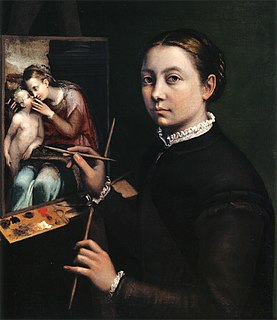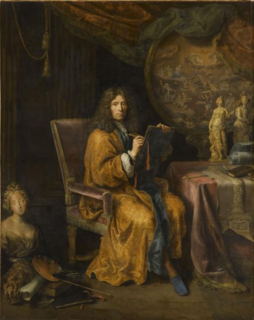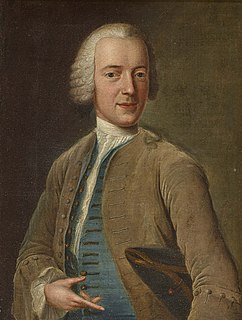Related Research Articles

Sofonisba Anguissola, also known as Sophonisba Angussola or Sophonisba Anguisciola, was an Italian Renaissance painter born in Cremona to a relatively poor noble family. She received a well-rounded education that included the fine arts, and her apprenticeship with local painters set a precedent for women to be accepted as students of art. As a young woman, Anguissola traveled to Rome where she was introduced to Michelangelo, who immediately recognized her talent, and to Milan, where she painted the Duke of Alba. The Spanish queen, Elizabeth of Valois, was a keen amateur painter and in 1559 Anguissola was recruited to go to Madrid as her tutor, with the rank of lady-in-waiting. She later became an official court painter to the king, Philip II, and adapted her style to the more formal requirements of official portraits for the Spanish court. After the queen's death, Philip helped arrange an aristocratic marriage for her. She moved to Sicily, and later Pisa and Genoa, where she continued to practice as a leading portrait painter.

Jacint Rigau-Ros i Serra, known in French as Hyacinthe Rigaud, was a Catalan-French baroque painter most famous for his portraits of Louis XIV and other members of the French nobility.

William Dobson was a portraitist and one of the first significant English painters, praised by his contemporary John Aubrey as "the most excellent painter that England has yet bred". He died relatively young and his final years were disrupted by the English Civil War.

Diego Rodríguez de Silva y Velázquez was a Spanish painter, the leading artist in the court of King Philip IV of Spain and Portugal, and of the Spanish Golden Age. He was an individualistic artist of the Baroque period. He began to paint in a precise tenebrist style, later developing a freer manner characterized by bold brushwork. In addition to numerous renditions of scenes of historical and cultural significance, he painted scores of portraits of the Spanish royal family and commoners, culminating in his masterpiece Las Meninas (1656).

Tiziano Vecelli or Vecellio, known in English as Titian, was an Italian (Venetian) painter during the Renaissance, considered the most important member of the 16th-century Venetian school. He was born in Pieve di Cadore, near Belluno. During his lifetime he was often called da Cadore, 'from Cadore', taken from his native region.

Sir Godfrey Kneller, 1st Baronet, was the leading portrait painter in England during the late 17th and early 18th centuries, and was court painter to English and British monarchs from Charles II to George I. His major works include The Chinese Convert ; a series of four portraits of Isaac Newton painted at various junctures of the latter's life; a series of ten reigning European monarchs, including King Louis XIV of France; over 40 "kit-cat portraits" of members of the Kit-Cat Club; and ten "beauties" of the court of William III, to match a similar series of ten of Charles II's mistresses painted by Kneller's predecessor as court painter, Sir Peter Lely.

Anthonis Mor, also known as Anthonis Mor van Dashorst and Antonio Moro, was a Netherlandish portrait painter, much in demand by the courts of Europe. He has also been referred to as Antoon, Anthonius, Anthonis or Mor van Dashorst, and as Antonio Moro, António Mouro, Anthony More, etc., but signed most of his portraits as Anthonis Mor.

Gerard van Honthorst was a Dutch Golden Age painter who became known for his depiction of artificially lit scenes, eventually receiving the nickname Gherardo delle Notti. Early in his career he visited Rome, where he had great success painting in a style influenced by Caravaggio. Following his return to the Netherlands he became a leading portrait painter.

Jules Joseph Lefebvre was a French figure painter, educator and theorist.

Pierre Mignard or Pierre Mignard I, called "Mignard le Romain" to distinguish him from his brother Nicolas Mignard, was a French painter known for his religious and mythological scenes and portraits. He was a near-contemporary of the Premier Peintre du Roi Charles Le Brun with whom he engaged in a bitter, life-long rivalry.

Alonso Sánchez Coello was an Iberian portrait painter of the Spanish and Portuguese Renaissance. He is mainly known for his portrait paintings executed in a style which combines the objectivity of the Flemish tradition with the sensuality of Venetian painting. He was court painter to Philip II.

Vladimir Lukich Borovikovsky was a prominent Russian Imperial artist of Ukrainian Cossack background, who served at the court of Catherine the Great and dominated portraiture in the Russian Empire at the turn of the 19th century.
Justus Sustermans, Joost Sustermans or Suttermans, his given name Italianised to Giusto, was a Flemish painter and draughtsman who is mainly known for his portraits. He also painted history and genre paintings, still lifes and animals.

Portrait painting is a genre in painting, where the intent is to represent a specific human subject. The term 'portrait painting' can also describe the actual painted portrait. Portraitists may create their work by commission, for public and private persons, or they may be inspired by admiration or affection for the subject. Portraits often serve as important state and family records, as well as remembrances.

A court painter was an artist who painted for the members of a royal or princely family, sometimes on a fixed salary and on an exclusive basis where the artist was not supposed to undertake other work. Painters were the most common, but the court artist might also be a court sculptor. In Western Europe, the role began to emerge in the mid-13th century. By the Renaissance, portraits, mainly of the family, made up an increasingly large part of their commissions, and in the Early Modern period one person might be appointed solely to do portraits, and another for other work, such as decorating new buildings.

Marcello Bacciarelli was a Polish-Italian painter of the late-baroque and Neoclassic periods.

Sir Peter Lely was a painter of Dutch origin whose career was nearly all spent in England, where he became the dominant portrait painter to the court.

The title of Principal Painter in Ordinary to the King or Queen of England or, later, Great Britain, was awarded to a number of artists, nearly all mainly portraitists. It was different from the role of Serjeant Painter, and similar to the earlier role of "King's Painter". Other painters, for example Nicholas Hilliard had similar roles with different titles. "Principal Painter in Ordinary", first used for Sir Anthony Van Dyck, became settled as the usual title with John Riley in 1689.

Henry Strangways, also sometimes known as Strangwish, was an English "Gentleman Pirate" who attacked Spanish and other shipping. He was repeatedly imprisoned, and pardoned by highly placed friends, during his approximately eight-year piratical career, from about 1552 to 1560. His portrait painted by a fellow prisoner, Gerlach Flicke, resides today in the National Portrait Gallery in London.

Johann Georg Ziesenis was a German – Danish portrait painter.
References
- Bryan, Michael (1889). Walter Armstrong; Robert Edmund Graves (eds.). Dictionary of Painters and Engravers, Biographical and Critical. Vol. II L-Z. London: George Bell and Sons. p. 355.